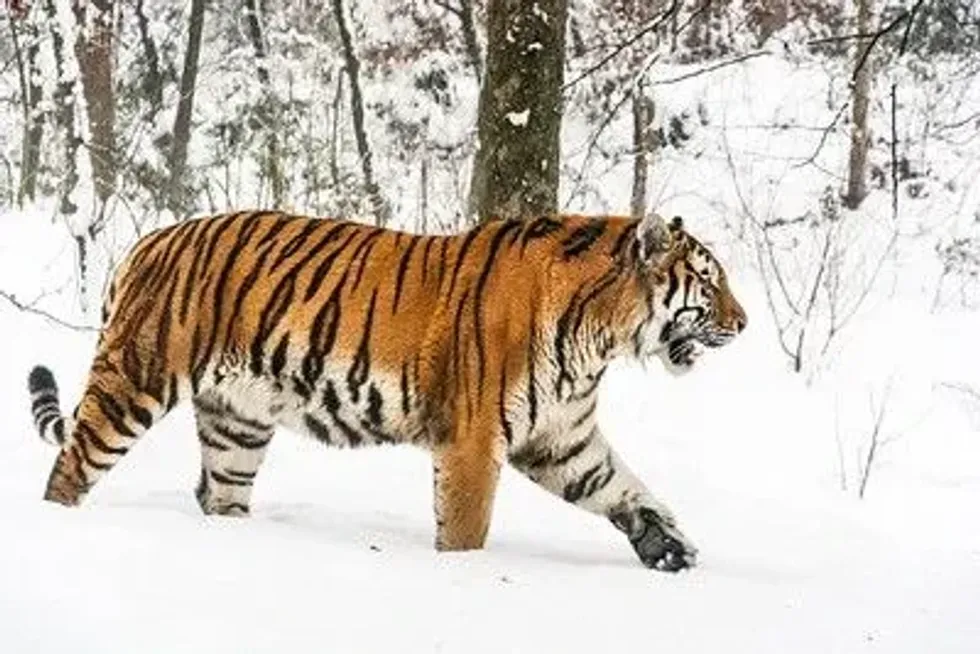The Siberian tiger (Panthera tigris altaica) is a specific population of the tiger subspecies Panthera tigris tigris. They also go by the names of Amur tiger, Northeast China tiger, Manchurian tiger, Ussurian tiger, and the Korean tiger, these iconic big cats are found in parts of Russia, China, and North Korea.
Of all types of tigers and tiger species found around the world, the Amur tiger is the largest with some males of the population growing to over ten feet in length!
The Siberian tiger can be easily distinguishable from other tiger species by their pale orange fur and prominent brown stripes. The Amur tiger has fewer and paler stripes compared to other tiger subspecies and in addition, they have a mane which is not seen in any other population of tigers.
With its powerful body and massive size, the majestic Amur tiger is physiologically adapted to survive in the harsh and freezing climate. The Siberian tiger is also a skillful predator and can hunt down almost any prey of any size.
The fur and bones of the Siberian tiger are of immense value and the resulting poaching activities are driving these royal beasts towards extinction.
Want to know more interesting facts about the Amur tiger? Then, read on!
Siberian Tiger Interesting Facts
What type of animal is a Siberian tiger?
The Siberian tiger (Panthera tigris altaica) is a carnivorous big cat and a subspecies of the tiger. A Siberian tiger is closely related to the Malayan tiger, Bengal tiger, and the Caspian tiger but their wild population is geographically distributed across Asia.
The Siberian tigers and other populations of the tiger species belong to the same genus as the leopard, jaguar, and lion.
What class of animal does a Siberian tiger belong to?
The Siberian tiger (Panthera tigris altaica) is a mammal and apex predator of order Carnivora and family Felidae.
How many Siberian tigers are there in the world?
The Siberian tiger population is dwindling due to threats like illegal trade, hunting, poaching, and habitat loss.
A census conducted in 2005 showed that there were around 423-502 Siberian tigers left in the wild which included cubs and adults. However, the subsequent years have shown a marked increase in the Siberian tiger population and according to the latest census of 2014-2015, there are around 480-540 Amur tigers (cubs and adults included) found in the wild habitat.
Although not Critically Endangered at present, the Siberian tigers come under the Endangered category of the International Union for Conservation of Nature (IUCN) Red List.
Where does a Siberian tiger live?
Siberian tigers live in the woods; they are found in the boreal forests, birch forests, and the taiga or snow forests.
What is a Siberian tiger's habitat?
Historically, Siberian tigers occupied a large area across the Korean peninsula, northeastern China, and the Russian far east. But due to habitat loss and the subsequent decrease in population, the subspecies is now found within a limited region of the Sikhote-Alin mountain range in the Primorsky and Khabarovsk Krais of Russia.
If not the entire Korean peninsula, the endangered species' habitat range extends a bit into North Korea as well as China.
The primary habitat of the Siberian tigers is characterized by severe and frigid climatic conditions with extremely cold winters and heavy snowfall.
These tiger subspecies prefer inhabiting remote mountainous regions that are far away from any kind of human interference. However, their choice of habitat significantly depends on the availability of prey.
Who do Siberian tigers live with?
Siberian tigers inhabit regions that are far away from human settlement. These endangered creatures have a solitary lifestyle and do not have any complex social structure.
Siberian tigers aggressively guard their territories either through scent-marking areas with urine or making claw marks on trees. Any animal that comes within the hunting grounds of the Siberian tiger falls prey to it.
How long does a Siberian tiger live?
The Siberian tiger lifespan is similar to other species of the cat family and they live for an average of 16-18 years. Considering that most Siberian tigers in the wild die of natural causes, their average lifespan ranges between 10-15 years. But those in captivity can go well into their twenties and live up to 25!
How do they reproduce?
Siberian tigers do not have any fixed breeding schedule and can reproduce at any time of the year. In fact, they begin breeding when they are about four years old.
The female tigers alert the males about their breeding receptiveness by leaving marks or scents around their territories.
Once the males meet the females, they court for some days, usually a week, and then the male departs. The females have a gestation period of around three or three-and-a-half months, after which they give birth to litters comprising two to six cubs.
The male Siberian tiger has no role in the rearing of the cubs and the females are left to fend for themselves and the young ones.
Since the cubs are born blind, they require special care and stay with their mothers up to the age of two to three years. It takes a few months for the cubs to be weaned off their mother's milk and they can only hunt for themselves when they are around a year-and-a-half old.
What is their conservation status?
The International Union for Conservation of Nature (IUCN) Red List categorized the Siberian tigers as Critically Endangered in 2007. But thanks to tiger conservation efforts, their numbers have rebound and they have now moved a notch up to the conservation status category Endangered.
However, like many other endangered species, illegal hunting, poaching, and habitat loss continue to be major threats to the survival of these spectacular beasts.
Low genetic diversity and poor enforcement of anti-poaching laws can further cause their population to decline. Reintroduction and captive breeding efforts by Russia and China are significant steps in the direction of conserving these tigers.
Siberian Tiger Fun Facts
What do Siberian tigers look like?

The large and powerful Siberian tigers possess a thick coat of pale orange fur with dark brown stripes. Their bellies and chests are whitish and a distinctive physical feature is the presence of a mane of fur which keeps the tiger's body warm in cold climates.
Besides, Siberian tigers have short pointy ears, thick paws with sharp claws, a striped tail, muscular body, and fearsome teeth. The area around their canines is quite broad and their skulls are strikingly large.
How cute are they?
Being an apex predator, Siberian tigers are not exactly 'cute'. While the cubs look adorable, the adults have a ferocious appearance and yet look elegant in their poise and demeanor.
How do they communicate?
Even though Siberian tigers spend most of their time alone, they have evolved efficient communication methods, the most important being scent marking. Both males and females spray urine mixed marking fluid and anal gland secretions onto trees and other upright objects in their territories.
These scents act as unique identifiers of the animal, including the individual's gender and breeding status.
Besides their well-developed sense of smell, tigers use visual signals as a means of communication with their own members; these cues may include claw marks, scrapes, and feces. Further, these tigers have different kinds of vocalizations ranging from growls, roars, and snarls to grunts, moans, hisses, spits, and occasional "meows".
How big is a Siberian tiger?
A Siberian tiger from the Sikhote-Alin mountains has an average body length ranging between 5.8-6.8 ft, but some of the largest males can reach a size of almost 10-11 ft. The average tail length is 3.2 ft in males and 2.9 ft in females.
Although the Siberian tigers are considered to be the largest subspecies of the tiger, they are approximately of the same size as that of a Bengal tiger.
How fast can a Siberian tiger run?
A Siberian tiger can run short distances at a speed of about 30-40 mph (49-65 km/hr).
How much does a Siberian tiger weigh?
On average, a modern male Siberian tiger weighs between 352.7-418.8 lb (160-190 kg). Females are smaller with an average body mass between 242.5-286.6 lb (110-130 kg).
What are their male and female names of the species?
Males are called tiger and the female ones tigress.
What would you call a baby Siberian tiger?
A baby Siberian tiger goes by the general name of cub.
What do they eat?
Siberian tigers are carnivorous and prey on hoofed animals such as wild boar, roe deer, elk, and others like salmon, rabbit, and occasionally bears.
Are they dangerous?
Of course, Siberian tigers are a danger to their prey but they are rarely known to be man-eaters. When they do become hostile towards humans, it is mostly because they are ill or injured.
Would they make a good pet?
Needless to say, big cats like the Siberian tiger are not suitable as pets due to their obvious aggressive nature.
Did you know...
Here are five unique and interesting facts about the Siberian tiger!
1. Rare instances have been reported of bears and wolves killing Siberian tigers.
2. Adult Siberian tigers need to eat as much as 20 oz (9 kg) of food every day to survive.
3. A Siberian tiger can travel up to 621 mi (1000 km) in search of prey or mate.
4. The coat of Siberian tigers changes with the seasons to help them with hunting.
5. The Siberian tiger is revered as a deity by the Tungusic peoples of Siberia.
Are Siberian tigers pack animals?
No, they are solitary and mark their scent on trees to keep others away.
How often do Siberian tigers hunt?
Although the Siberian tiger is a stealthy predator, not all ambushes are successful and they have to hunt often while being constantly vigilant about potential prey.
Here at Kidadl, we have carefully created lots of interesting family-friendly animal facts for everyone to discover! You can even occupy yourself at home by drawing one on our Siberian tiger coloring pages.










